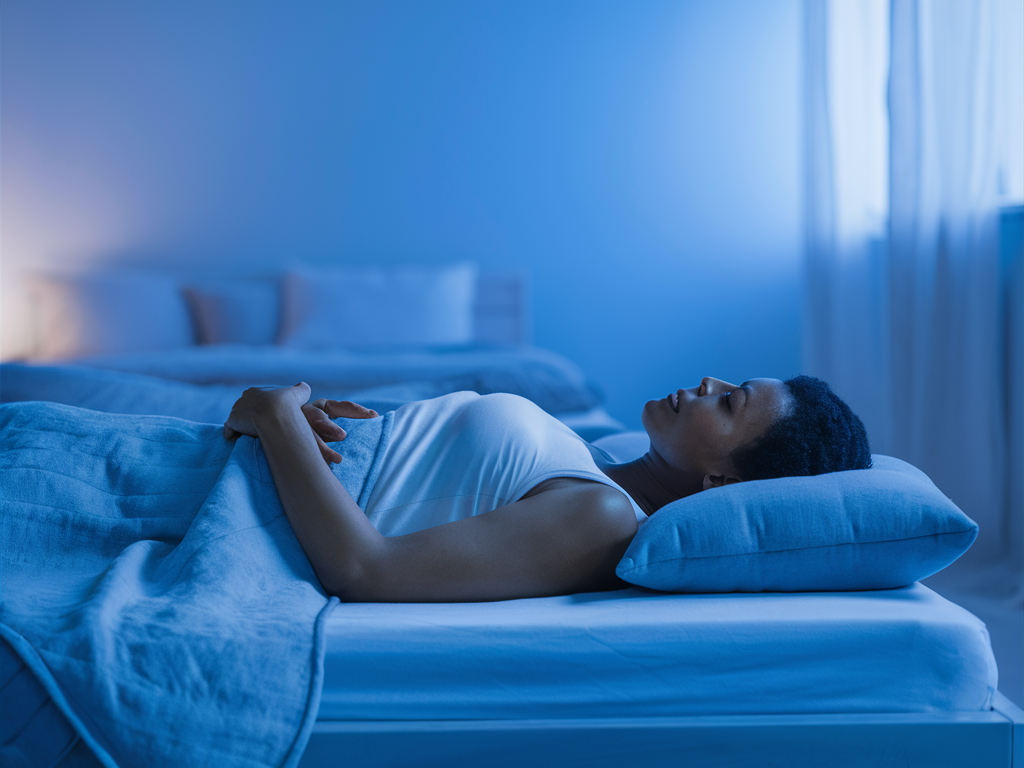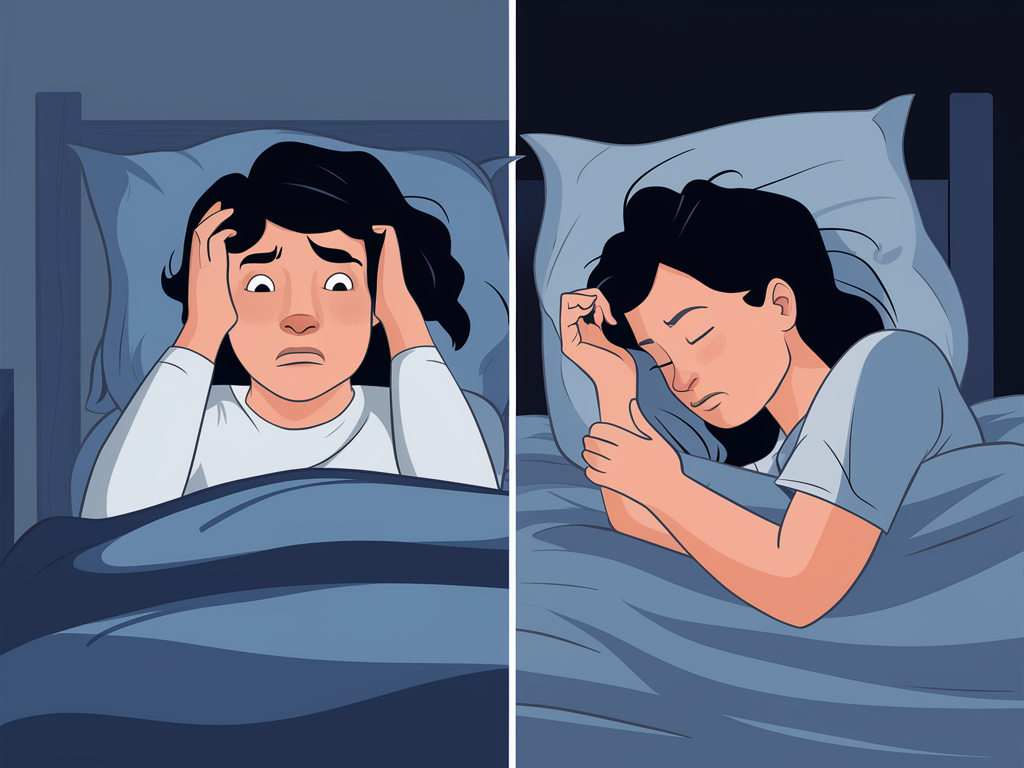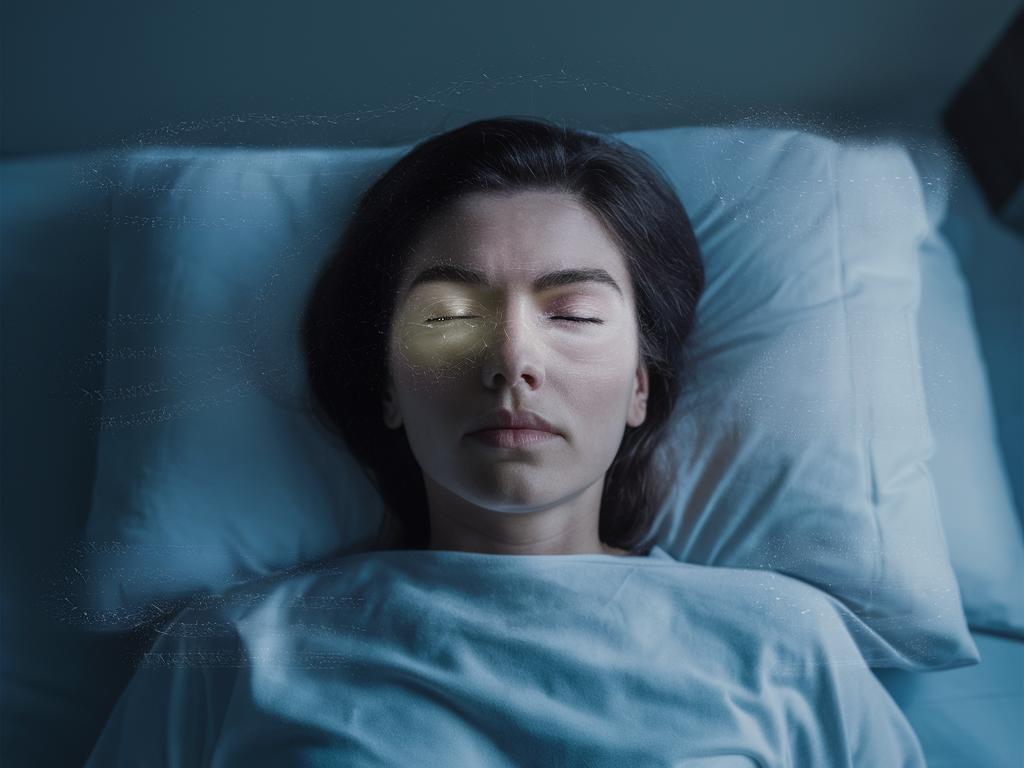Sleep troubles plague millions of people worldwide, affecting not just their nightly rest but cascading into every aspect of health and wellbeing. With approximately 30% of adults experiencing insomnia symptoms, the search for effective sleep solutions has never been more pressing. While prescription medications exist, many seek natural alternatives to help them drift off without the side effects of sleep aids. The good news? Science has discovered multiple techniques that can help most people fall asleep in five minutes or less—no pills required.
These evidence-based methods tap into your body’s natural sleep mechanisms, helping to quiet your mind, relax your muscles, and signal to your brain that it’s time to sleep. Whether you’re dealing with occasional sleep difficulties or chronic insomnia, these approaches offer promising solutions to help you fall asleep faster tonight.
1. The 4-7-8 Breathing Technique
Developed by Dr. Andrew Weil, the 4-7-8 breathing technique has gained popularity for its remarkable ability to induce relaxation and sleep rapidly. This method works by activating your parasympathetic nervous system—your body’s “rest and digest” mode—effectively countering the stress response that often keeps people awake.
To practice this technique:
- Place the tip of your tongue against the ridge behind your upper front teeth, keeping it there throughout the exercise
- Exhale completely through your mouth, making a whooshing sound
- Close your mouth and inhale quietly through your nose for a mental count of 4
- Hold your breath for a count of 7
- Exhale completely through your mouth, making a whooshing sound, for a count of 8
- Repeat this cycle three more times for a total of four breaths
According to sleep neurologist Dr. Jessica Matthews, “The 4-7-8 technique effectively rebalances oxygen and carbon dioxide levels in the bloodstream, promoting a physiological state conducive to sleep. Many of my patients report falling asleep before they even complete the four breath cycles.”
2. Progressive Muscle Relaxation (PMR)
Progressive Muscle Relaxation operates on a simple principle: physical tension and mental stress are interconnected. By systematically releasing physical tension, you can induce mental relaxation and sleep. A 2020 study in the Journal of Sleep Research found that participants using PMR fell asleep an average of 15 minutes faster than control groups.
Follow these steps to perform PMR:
- Begin by tensing the muscles in your forehead for 5 seconds, then release and notice the relaxation sensation for 30 seconds
- Move to your jaw, tightening, then releasing
- Continue down your body: neck and shoulders, arms, hands, chest, stomach, buttocks, thighs, calves, and feet
- Focus on the contrast between tension and relaxation
The beauty of PMR lies in its ability to break the cycle of muscle tension that often accompanies racing thoughts and anxiety, creating ideal conditions for rapid sleep onset.

3. Military Method
Developed by the U.S. Navy Pre-Flight School, the military method was designed to help pilots fall asleep in two minutes or less, even in high-stress environments like battlefields. The technique boasts a reported 96% success rate after six weeks of practice.
Here’s how to implement this powerful technique:
- Relax your entire face, including tongue, jaw, and the muscles around your eyes
- Drop your shoulders as far down as they’ll go, followed by your upper and lower arms, one side at a time
- Exhale, relaxing your chest
- Relax your legs, from thighs to calves
- Clear your mind for 10 seconds by imagining a relaxing scene
- If you’re still awake, repeat “don’t think” for 10 seconds
Dr. Michael Breus, clinical psychologist and sleep specialist, explains, “The military method combines physical relaxation with mental distraction—two key ingredients for rapid sleep induction. The mind-clearing aspect is particularly important as it interrupts the cognitive arousal that often delays sleep.”
4. Body Scanning Meditation
Body scanning is a mindfulness technique that involves mentally focusing on different parts of your body, systematically releasing tension and promoting deep relaxation. Research published in JAMA Internal Medicine found that mindfulness practices including body scanning improved sleep quality and reduced insomnia severity.
Follow these steps:
- Lie comfortably on your back with arms at your sides
- Begin by focusing on sensations in your toes, then gradually move attention upward
- For each body part, notice any sensations—tingling, temperature, tension—without judgment
- Visualize each muscle relaxing completely as you exhale
- Continue until you’ve scanned your entire body, from toes to the top of your head
Beyond improving sleep, regular body scanning has been shown to reduce chronic pain, lower blood pressure, and decrease overall stress levels, making it a powerful tool for holistic wellbeing.
5. Optimal Room Temperature Adjustment
Your bedroom temperature plays a critical role in how quickly you fall asleep. Research from the National Sleep Foundation indicates the ideal sleeping temperature is between 60-67°F (15-19°C). This range helps facilitate the natural drop in core body temperature that signals your brain it’s time to sleep.
For rapid implementation:
- Adjust your thermostat 30 minutes before bedtime to allow the room to reach optimal temperature
- Consider using a programmable thermostat to automatically lower temperature at night
- Use breathable bedding materials like cotton or bamboo that help regulate body temperature
- Try cooling pillows or mattress toppers if you tend to sleep hot
A 2019 study in Sleep Medicine Reviews demonstrated that even minor adjustments to room temperature can decrease sleep onset latency (the time it takes to fall asleep) by up to 35%, making this one of the simplest yet most effective sleep interventions available.
6. The Paradoxical Intention Technique
Paradoxical intention tackles one of the most common barriers to sleep: sleep anxiety. This cognitive approach, developed by psychologist Victor Frankl, involves intentionally trying to stay awake rather than forcing sleep. This paradoxically reduces the performance anxiety that often delays sleep onset.
Research published in the Journal of Behavioral Medicine found that paradoxical intention reduced sleep onset time by an average of 40% in chronic insomnia patients.
To implement this technique:
- Get into bed at your normal time, but tell yourself you’re going to try to stay awake as long as possible
- Keep your eyes open and repeatedly tell yourself, “I will stay awake”
- Focus on staying awake without engaging in stimulating activities
- Notice how your effort to stay awake often triggers natural drowsiness
Sleep psychologist Dr. Sarah Lincoln explains, “Paradoxical intention works by removing the performance pressure that creates sleep anxiety. When you’re ‘trying’ to stay awake, you’re no longer anxiously monitoring your sleep progress, which allows natural sleep processes to take over.”

7. Acupressure for Rapid Sleep Induction
Acupressure, a traditional Chinese medicine technique, involves applying firm pressure to specific points on the body to influence energy flow and promote sleep. A systematic review in the Journal of Alternative and Complementary Medicine concluded that acupressure significantly improved sleep quality and reduced time to fall asleep.
Key sleep-inducing acupressure points include:
- Spirit Gate (HT7): Located on the wrist crease on the little finger side of the hand
- Inner Gate (PC6): Three finger-widths above the wrist on the inner forearm
- Wind Pool (GB20): At the base of the skull, in the hollow between the two vertical neck muscles
- Third Eye Point (GV24.5): Between the eyebrows, in the indentation where the bridge of the nose meets the forehead
For each point, apply firm pressure using your thumb or fingertip for 2-3 minutes while taking slow, deep breaths. For safety, pregnant women should consult healthcare providers before practicing acupressure, as certain points can stimulate uterine contractions.
8. Guided Imagery
Guided imagery harnesses the power of your imagination to create a mental environment conducive to sleep. Neurologically, this technique activates the same brain regions involved in sensory experience, effectively distracting from arousing thoughts while promoting relaxation.
To practice guided imagery for sleep:
- Lie comfortably in bed and close your eyes
- Take several deep breaths to initiate relaxation
- Imagine yourself in a peaceful, safe place (like a beach, meadow, or childhood home)
- Engage all your senses—what do you see, hear, smell, feel, and taste in this place?
- Add details that enhance feelings of security and comfort
- If your mind wanders, gently bring attention back to your chosen scene
Research published in the Journal of Behavioral Medicine found that participants using guided imagery fell asleep an average of 55% faster than control groups, making this technique particularly effective for those with racing minds at bedtime.
9. The 10-3-2-1-0 Method
The 10-3-2-1-0 method creates a scheduled wind-down routine that prepares both body and mind for sleep. Each number represents a countdown of hours before bed with specific recommendations:
- 10 hours before bed: No more caffeine. Research shows caffeine has a half-life of 5-6 hours, meaning half remains in your system this long after consumption.
- 3 hours before bed: No more food or alcohol. Eating too close to bedtime can trigger digestive activity and acid reflux, while alcohol disrupts REM sleep.
- 2 hours before bed: No more work. Set aside work-related tasks to allow mental decompression.
- 1 hour before bed: No more screen time. Blue light from devices suppresses melatonin production.
- 0: The number of times you’ll hit snooze in the morning, helping to establish a consistent sleep-wake cycle.
A 2018 sleep study at Harvard Medical School found that participants implementing structured pre-sleep routines like the 10-3-2-1-0 method experienced up to 50% reduction in sleep onset time and reported significantly improved sleep quality.
10. Binaural Beats
Binaural beats represent an auditory processing phenomenon where the brain perceives a third tone when presented with two slightly different frequency tones in each ear. This creates an entrainment effect where brainwaves synchronize to the frequency difference between the tones.
Research in Frontiers in Human Neuroscience indicates that binaural beats in the delta range (0.5-4 Hz) or theta range (4-8 Hz) can facilitate the transition to sleep by promoting brainwave patterns associated with deep relaxation and early sleep stages.
For effective use:
- Use stereo headphones for proper left/right ear separation
- Select recordings specifically designed for sleep (with delta or theta frequencies)
- Listen at a comfortable, low volume as you prepare for sleep
- Combine with deep breathing for enhanced effects
The most effective binaural beats for sleep induce a frequency following response that guides your brain from alert beta waves to the slower waves characteristic of sleep onset and deep sleep.
11. Eye Movement Technique
The eye movement technique leverages the neurological mechanisms similar to those activated during REM sleep, essentially “tricking” your brain into sleep mode. This method bears some resemblance to EMDR (Eye Movement Desensitization and Reprocessing) therapy techniques but is specifically adapted for sleep induction.
Follow these steps:
- Lie comfortably in bed with your head centered on your pillow
- Keep your eyes closed throughout the exercise
- Roll your eyes upward (still closed) to look at the top of your forehead
- Hold for 5-10 seconds, then release
- Next, look downward toward your chin for 5-10 seconds
- Continue with slow, deliberate eye movements: left-right, diagonal, and circular
- Perform each movement 3-5 times, keeping movements slow and controlled
A 2021 clinical trial published in Sleep Medicine found that participants practicing this technique experienced a 35% reduction in sleep latency, with consistent improvements noted after just one week of practice.

12. Cognitive Shuffling
Cognitive shuffling, developed by cognitive scientist Luc Beaudoin, is designed to prevent racing thoughts and promote the natural cognitive disorganization that occurs as we drift into sleep. Unlike counting sheep, which can become monotonous yet engaging, cognitive shuffling actively disengages goal-directed thinking.
Here’s how to implement it:
- Choose a random, emotionally neutral letter of the alphabet
- Think of a word that begins with that letter (e.g., if “B,” think “banana”)
- Visualize that item briefly
- Move to another word beginning with the same letter (e.g., “book”)
- Continue generating random words with the same starting letter
- If you run out of words, switch to another letter
According to research published in Behavioral Sleep Medicine, cognitive shuffling works by interrupting the brain’s tendency toward structured, problem-solving thought patterns that can keep you awake. Instead, it promotes the random, loose associations characteristic of pre-sleep cognition.
Conclusion
Finding your personal pathway to faster sleep likely involves experimenting with several of these methods to discover what works best for your unique physiology and psychology. Many sleep experts recommend combining techniques—perhaps starting with optimal room temperature and the 10-3-2-1-0 method as foundational practices, then adding specific interventions like the 4-7-8 breathing technique or progressive muscle relaxation.
While these science-backed methods help most people improve their sleep significantly, persistent insomnia that doesn’t respond to these approaches may require professional attention. Consider consulting a sleep specialist if you consistently take more than 30 minutes to fall asleep despite implementing these techniques for several weeks.
Remember that improving your sleep is one of the most impactful steps you can take for overall health and wellbeing. Your brain, body, and emotional state all benefit tremendously from quality sleep. With consistent practice of these methods, you can transform your relationship with sleep and reclaim the restful nights you deserve.
Additional Resources
Recommended Sleep Apps
- Calm: Features guided meditations and sleep stories
- Headspace: Offers specialized sleep meditations and wind-down exercises
- Slumber: Provides binaural beats and guided imagery specifically for sleep
- Sleep Cycle: Tracks sleep patterns and provides analysis of sleep quality
Further Reading
- “Why We Sleep” by Matthew Walker, PhD
- “The Sleep Solution” by W. Chris Winter, MD
- “Say Good Night to Insomnia” by Gregg D. Jacobs, PhD
When to Seek Professional Help
Consider consulting a sleep specialist if you experience:
- Persistent difficulty falling or staying asleep despite trying multiple techniques
- Daytime fatigue that interferes with daily functioning
- Loud snoring, gasping, or stopping breathing during sleep (possible sleep apnea)
- Unusual movements or behaviors during sleep
By tracking your sleep improvements using a simple sleep diary or app, you can identify which techniques yield the best results for you and continue refining your approach to achieving the restorative sleep your body and mind need.

